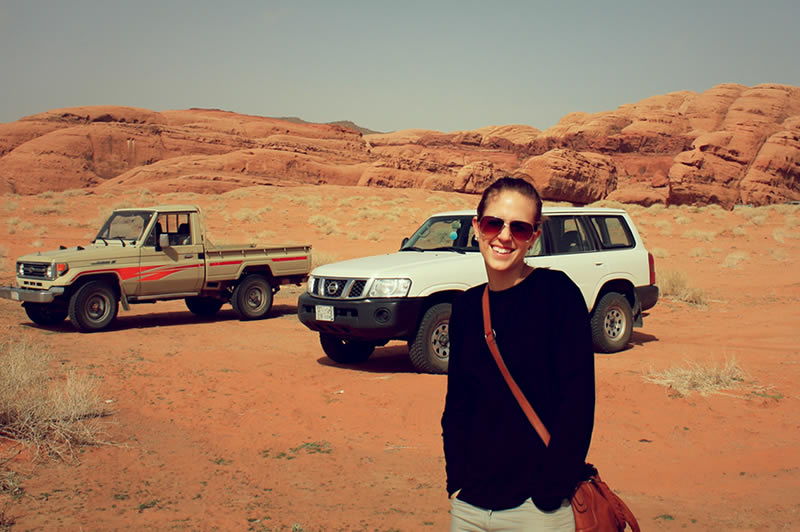While on a 2011 research trip to northwestern Saudi Arabia, College of the Humanities BA Religion student, Anik Laferriere, was exploring a remote part of the Ḥismā sand desert – home to the mystical and isolated temple of al-Ruwāfa, when she stumbled on something extraordinary.
Ruwāfa is a small, well preserved second-century structure that is a one-off in the vastness of the northwest desert of Arabia. Despite being in close proximity to water supplies (but little else), there is no evidence of any substantial human settlement at the site. Why this temple was built in such a seemingly impractical area has been a point of debate among researchers for a very long time. Astoundingly, the obscure location of this temple is only one contributing aspect of its greater exceptionality. What makes Ruwāfa even more remarkable are five Greek and Nabataean inscriptions that describe the structure as being constructed during the reign Marcus Aurelius and Lucius Verus, making the temple a famous attestation of Roman interaction in the Middle East.
While inspecting the site in 2011, Laferriere tripped over a castaway stone. As she collected her belongings, she instinctively took a fleeting look at the culprit of her impromptu sit-down on the desert’s sandy floor. In this glance, she noticed an unrecognizable Greek inscription on the stone at fault. She shouted to her trusted colleague, mentor and research travelling companion, Prof. Greg Fisher from Carleton’s College of Humanities and asked him to come have a look.
Laferriere and Fisher analyzed the stone, and were quick to acknowledge and note its unusual Roman markings. Little did they know, this inconvenient rock would be the key to unlocking a missing piece of an archeological puzzle that has been baffling al-Ruwāfa researchers for more than a half-century.

Laferriere at Ruwafa in 2011
It was not until Fisher was editing a contribution for his new book from one of the world’s foremost epigraphy experts, Michael C.A. Macdonald, that he realized he and Laferriere may have very literally stumbled on a profound re-discovery.
In the draft of his contribution to Fisher’s book, Macdonald wrote about a lost inscribed stone that was last seen in 1956/’57 when celebrated British explorer St. John Philby had copied it. In Macdonald’s research, he included a note that Philby had drawn the stone, but that its current location was a mystery, and assumed by many to have been eternally misplaced.
When Fisher read this, he immediately recalled that he had seen an inscribed stone at Ruwāfa that matched Macdonald’s description when his colleague had tripped over it.
“The discovery of the ‘lost stone’ was very exciting, as a completely new edition of the Ruwāfa inscriptions was prepared for my forthcoming edited book, Arabs and Empires Before Islam. Michael Macdonald had only the drawing made by Philby in 1957 before we realized that in my stash of photos, was something quite exciting,” said Fisher.
This meant that it was quite likely that Fisher and Laferriere were the first two people to realize the whereabouts of the stone in decades.
“The serendipity of the discovery seems incredible to me,” said Laferriere. “We were unaware at the time that it held any significance whatsoever, except as an example of Roman presence in the area. When we found out that this particular inscription had been missing for about 50 years, we could not believe our luck!”
Thanks to the meticulous assistance of Macdonald, they were able to confirm in 2014 that the impression they found was indeed Philby’s lost stone.
Referred as “Inscription III,” it is the third of five Greek and Nabataean Ruwāfa inscriptions that serve as attestation to Roman interest in Saudi Arabia. The set of inscriptions refer to the erection of the temple of al-Ruwāfa by a group of people called Thamud, the name of a nomadic tribe who had encountered the Assyrians in the latter parts of the eighth century BC, and to the Roman emperor Marcus Aurelius and co-emperor Lucius Verus.
The long-lost third engraving makes mention of Verus, who died in 169, meaning that the inscription was forged while he was still living, prior date to 169.
All inscriptions, save Inscription III, are currently displayed in the Riyadh museum. Needless to say, the found Inscription has initiated many new questions about the site, on the historical significance it holds, and how it will shape our present understanding of early Roman political and diplomatic interest in the Arabian Peninsula.
Fisher’s forthcoming book, which is slated for release with Oxford University Press in spring 2015, will address these questions, including a new reading of the group of inscriptions by Macdonald accompanied by new drawings of the temple. Arabs and Empires Before Islam will function as the most up-to-date version of this influential inscription and will offer readers a much more complete version of this important testament to Roman interest in Arabia than has ever been made available before.
Fisher hopes that this miraculous series of events will remind burgeoning researchers that unearthing the past is not always a particularly predictable venture.
“From the perspective of a teacher, the discovery shows students that while the material is most certainly ancient, new discoveries can and do happen all the time – and sometimes, quite by accident,” he said.
Monday, February 2, 2015 in Arts and Social Sciences, Bachelor of Arts
Share: Twitter, Facebook



